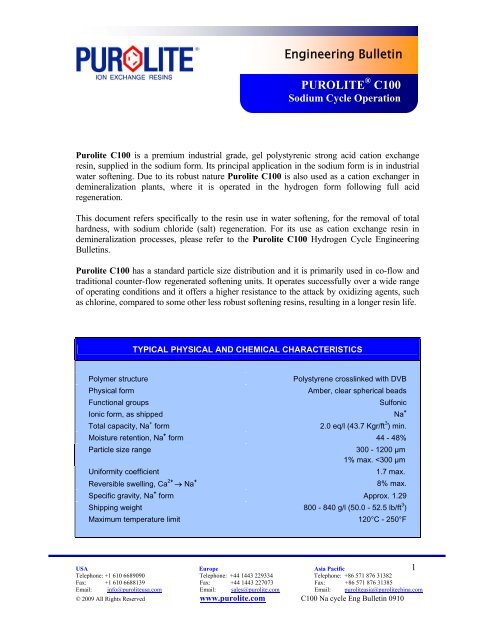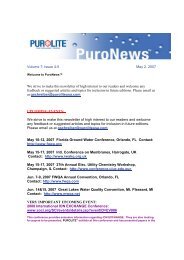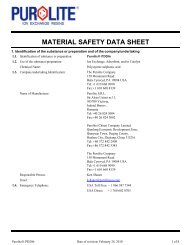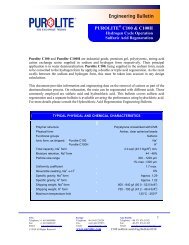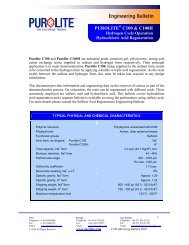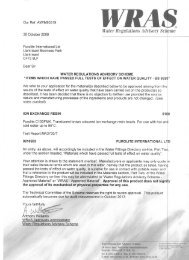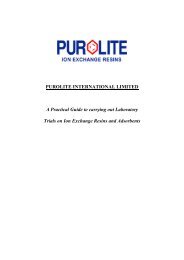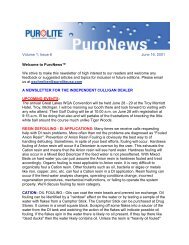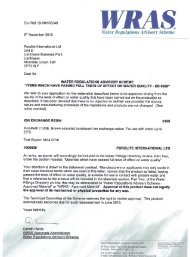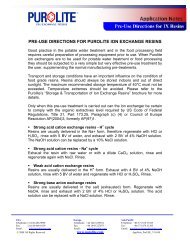PUROLITE C100 Engineering Bulletin - Purolite.com
PUROLITE C100 Engineering Bulletin - Purolite.com
PUROLITE C100 Engineering Bulletin - Purolite.com
Create successful ePaper yourself
Turn your PDF publications into a flip-book with our unique Google optimized e-Paper software.
<strong>Engineering</strong> <strong>Bulletin</strong><br />
<strong>PUROLITE</strong> ® <strong>C100</strong><br />
Sodium Cycle Operation<br />
<strong>Purolite</strong> <strong>C100</strong> is a premium industrial grade, gel polystyrenic strong acid cation exchange<br />
resin, supplied in the sodium form. Its principal application in the sodium form is in industrial<br />
water softening. Due to its robust nature <strong>Purolite</strong> <strong>C100</strong> is also used as a cation exchanger in<br />
demineralization plants, where it is operated in the hydrogen form following full acid<br />
regeneration.<br />
This document refers specifically to the resin use in water softening, for the removal of total<br />
hardness, with sodium chloride (salt) regeneration. For its use as cation exchange resin in<br />
demineralization processes, please refer to the <strong>Purolite</strong> <strong>C100</strong> Hydrogen Cycle <strong>Engineering</strong><br />
<strong>Bulletin</strong>s.<br />
<strong>Purolite</strong> <strong>C100</strong> has a standard particle size distribution and it is primarily used in co-flow and<br />
traditional counter-flow regenerated softening units. It operates successfully over a wide range<br />
of operating conditions and it offers a higher resistance to the attack by oxidizing agents, such<br />
as chlorine, <strong>com</strong>pared to some other less robust softening resins, resulting in a longer resin life.<br />
TYPICAL PHYSICAL AND CHEMICAL CHARACTERISTICS<br />
Polymer structure Polystyrene crosslinked with DVB<br />
Physical form Amber, clear spherical beads<br />
Functional groups Sulfonic<br />
Ionic form, as shipped Na +<br />
Total capacity, Na + form 2.0 eq/l (43.7 Kgr/ft 3 ) min.<br />
Moisture retention, Na + form 44 - 48%<br />
Particle size range 300 - 1200 µm<br />
1% max.
Available Grades<br />
<strong>Purolite</strong> <strong>C100</strong> is available in different grades, all supplied in the Na + form.<br />
- <strong>Purolite</strong> <strong>C100</strong> is a standard grade resin with a Gaussian particle size distribution in the<br />
range 300-1200 μm. Its principal application is in co-flow and traditional counter-flow<br />
regenerated softening and demineralization plants, where classification of the bed inside the<br />
operating vessel is possible.<br />
- <strong>Purolite</strong> <strong>C100</strong>C is a modified grade with a particle size in the range 400-1200 μm, for use<br />
in high flow rate applications where the standard grade resin would present an unacceptably<br />
high pressure drop across the bed.<br />
- Purofine ® PF<strong>C100</strong> is a Uniform Particle Size product with a mean particle size of 570 µm<br />
and a UC of 1.1-1.2, offering improved performance in softening and demineralisation<br />
systems, with regard to capacity, leakage, pressure drop and rinse water requirements.<br />
- Puropack PP<strong>C100</strong> is another Uniform Particle Size product, offering similar advantages,<br />
but with a mean particle size of 650 µm. This product has been specifically developed for<br />
the PUROPACK ® system and other packed bed counter-flow designs employing either upflow<br />
or down-flow service operation. Both Purofine ® PF<strong>C100</strong> and Puropack ® PP<strong>C100</strong><br />
have also seen successful operation in short cycle plants.<br />
- <strong>Purolite</strong> <strong>C100</strong>DL is a specially designed, coarse grade resin, with a particle size range of<br />
630-1200 μm. Its principal application is in layered bed cation exchange units in<br />
conjunction with a DL grade <strong>Purolite</strong> weak acid cation resin such as <strong>Purolite</strong><br />
C104DLPlus.<br />
- <strong>Purolite</strong> <strong>C100</strong>S is a specially cleaned and trimmed food grade resin with a particle size in<br />
the range 400-1200 μm, for use in food processing, such as in the sugar industry.<br />
Typical Operating Data (Guide to Service Operation and Regeneration)<br />
Service Operation<br />
In service operation hard water is normally pumped through the resin bed, which is retained<br />
within a pressure vessel. The vessel has top and bottom distribution / collection systems. These<br />
systems are designed to ensure the raw water passes evenly through the ion exchange bed in<br />
service operation. As the water passes through the resin, the hardness (principally calcium and<br />
magnesium) is exchanged with sodium ions. Hence the treated softened water has a higher<br />
sodium content and a somewhat higher conductivity. When the resin is exhausted it is then<br />
regenerated with a NaCl solution to put the resin back into the sodium form, ready for the next<br />
service operation. Therefore the internal systems also have to efficiently distribute and collect<br />
the regenerant brine solution, rinses, etc.<br />
USA Europe Asia Pacific<br />
2<br />
Telephone: +1 610 6689090 Telephone: +44 1443 229334 Telephone: +86 571 876 31382<br />
Fax: +1 610 6688139 Fax: +44 1443 227073 Fax: +86 571 876 31385<br />
Email: info@puroliteusa.<strong>com</strong> Email: sales@purolite.<strong>com</strong> Email: puroliteasia@purolitechina.<strong>com</strong><br />
© 2009 All Rights Reserved www.purolite.<strong>com</strong> <strong>C100</strong> Na cycle Eng <strong>Bulletin</strong> 0910
In service operation optimum performance is achieved at service flow rates between 8 and 40<br />
BV/h (Bed Volumes per hour) or 1 to 5 gpm/ft 3 (US gallons per minute per cubic foot of resin)<br />
within linear flow rates (velocities) of 10 to 50 m 3 /m 2 /h (m/h) or 4 to 20 gpm/ft 2 (US gallons<br />
per minute per square foot of vessel cross section), whereas brine regeneration is carried out at<br />
flow rates of 2 to 4 BV/h or 0.25 to 0.5 gpm/ft 3 . Within these limits internal distribution /<br />
collection systems can operate efficiently both at the higher service and lower regenerant flow<br />
rates. At very low service flow rates channelling can occur within the resin bed resulting in<br />
poor plant performance and short capacity between regenerations. This is particularly likely<br />
when long service cycles are also employed at these low flow rates.<br />
While some small industrial and domestic softeners operate with very shallow bed depths, bed<br />
depths below 610 mm (2 ft) should be avoided and preferably bed depths greater than 1000 mm<br />
(3 ft 3 in) employed. Vessel height and pressure drop are normally the controlling factor on the<br />
maximum height of the bed. For <strong>Purolite</strong> <strong>C100</strong> we re<strong>com</strong>mend that pressure drop across the<br />
bed should be maintained at less than 150 kPa (22 psi), having made allowance for bed<br />
<strong>com</strong>paction and any solids loading across a classified bed. Bed depths greater than 2000 mm<br />
(6 ft 6 in) are rarely encountered. The ratio of height to diameter is important in any ion<br />
exchange unit design.<br />
Although smaller freeboards are sometimes encountered, we re<strong>com</strong>mend a minimum 75%<br />
freeboard (space) above the resin bed to allow at least 50% bed expansion during backwash.<br />
This is normally adequate for a co-flow regenerated vessel, and assures a good hydraulic<br />
classification of the resin bed.<br />
Service operation is usually terminated by detection of hardness leakage, or volumetric<br />
throughput (water meter control), or on a time basis (time clock control). Regeneration can be<br />
manually or automatically initiated via the control system.<br />
While co-flow regenerated resin beds with backwashing will tolerate a low level of suspended<br />
solids present in the in<strong>com</strong>ing water supply, the resin bed should not be expected to work as a<br />
mechanical filter. Adequate pre-treatment should always be included if optimum resin<br />
performance is required.<br />
Regeneration<br />
The resin regeneration can be performed either co-flow or counter-flow. The regeneration is<br />
termed co-flow when the regenerant flows through the resin bed in the same direction,<br />
normally downwards or “top to bottom”, in which the water flows during the service operation.<br />
When the regenerant flow is in the opposite direction to service flow, then the term used is<br />
counter-flow regeneration. Other terms such as co-current and counter-current are also used to<br />
describe these two principal regeneration techniques.<br />
USA Europe Asia Pacific<br />
3<br />
Telephone: +1 610 6689090 Telephone: +44 1443 229334 Telephone: +86 571 876 31382<br />
Fax: +1 610 6688139 Fax: +44 1443 227073 Fax: +86 571 876 31385<br />
Email: info@puroliteusa.<strong>com</strong> Email: sales@purolite.<strong>com</strong> Email: puroliteasia@purolitechina.<strong>com</strong><br />
© 2009 All Rights Reserved www.purolite.<strong>com</strong> <strong>C100</strong> Na cycle Eng <strong>Bulletin</strong> 0910
It should be remembered when counter-flow regeneration is employed, it is important that in<br />
the up flow stage(s) the bed must remain static and hence packed beds, air hold down, split<br />
flow and water hold down are just some of the systems employed to achieve this requirement.<br />
Co-flow regeneration<br />
The co-flow regeneration technique is normally made up of 5 steps and typically takes between<br />
1 and 2 hours depending on the detailed design. For this type of regeneration, the influent water<br />
is usually of adequate quality for all steps, including regenerant dilution.<br />
The first step of co-flow regeneration is backwash. The backwash water enters the unit through<br />
the bottom collection / distribution system, loosening the bed and causing the bed to expand as<br />
the water passes up through it. The flow rate should be set for the freeboard available in the unit<br />
at the minimum water temperature. The backwash is designed to both de<strong>com</strong>pact the resin, for<br />
better regenerant contact, as well as for removing any suspended solids that have been filtered<br />
out of the in<strong>com</strong>ing supply and accumulated within the bed. The backwash water volume<br />
required will depend on the extent of solids loading. Where the bed only requires loosening for<br />
better regenerant contact then 1 FBV (free board volume) is normally sufficient. However,<br />
when filtered solids are present the volume required can be considerably greater. After the<br />
backwash a “bed settle” step is required.<br />
The bed settle allows the resin to settle back and reform the static bed prior to regenerant<br />
injection. Depending on the size of the bed, free board, and backwash rate used, this step can<br />
take between 3 and 8 minutes.<br />
Regenerant injection at the correct flow rate and brine concentration are critical. Good contact<br />
between the NaCl solution (brine) and the resin is essential for optimum performance. <strong>Purolite</strong><br />
re<strong>com</strong>mend the brine is introduced at 10% concentration. Experience shows that at<br />
concentrations above and below this strength a small loss in performance can be expected. The<br />
brine should be introduced at 2 to 4 BV/h (0.25 to 0.5 gpm/ft 3 ) and the regeneration level<br />
(amount of NaCl per litre of resin) employed will typically be between 80 and 160 g/l (5 – 10<br />
lb/ft 3 ), though regeneration levels as low as 50 g/l (3 lb/ft 3 ) and as high as 250 g/l (16 lb/ft 3 )<br />
have been employed.<br />
The slow (regenerant displacement) rinse is always carried out at flow rates similar to the brine<br />
injection step. This is to ensure, first, a uniform contact time between the resin and the<br />
regenerant solution and, second, that the rinse water follows the same route of the regenerant<br />
through the resin bed. As slow rinses are usually more efficient in removing the spent<br />
regenerant from the resin, the more slow rinsing employed can be beneficial in reducing the<br />
amount of final rinse required at the end of the regeneration. Normally 1 to 3 BV (7.5 to 22.5<br />
gal/ft 3 ) of slow rinse are applied.<br />
The final rinse is often carried out at the service flow rate and this also acts as a proving<br />
condition prior to returning to service after regeneration. On some occasions, where flow<br />
USA Europe Asia Pacific<br />
4<br />
Telephone: +1 610 6689090 Telephone: +44 1443 229334 Telephone: +86 571 876 31382<br />
Fax: +1 610 6688139 Fax: +44 1443 227073 Fax: +86 571 876 31385<br />
Email: info@puroliteusa.<strong>com</strong> Email: sales@purolite.<strong>com</strong> Email: puroliteasia@purolitechina.<strong>com</strong><br />
© 2009 All Rights Reserved www.purolite.<strong>com</strong> <strong>C100</strong> Na cycle Eng <strong>Bulletin</strong> 0910
estrictions occur, the plant final rinse is carried out at a lower than the service flow rate.<br />
Normally 3 to 6 BV (22.5 to 45 gal/ft 3 ) are required depending on the design of the distribution<br />
/ collection system and the amount of slow rinsing previously performed.<br />
Typical Operating Conditions for Co-flow Regeneration<br />
Step Design Basis Duration<br />
Backwash Set for minimum water temperature to<br />
give 50% bed expansion<br />
Bed settle To allow the bed to reform fully<br />
classified<br />
NaCl injection 50-250 g/l (3-15 lb/ft 3 ) applied as a<br />
10% brine solution at 2-4 BV/h (0.25 to<br />
0.5 gpm/ft 3 )<br />
Slow rinse 1-3 BV (7.5 to 22.5 gal/ft 3 ) at approx.<br />
regenerant flow rate<br />
Final rinse 3-6 BV (22.5 to 45 gal/ft 3 ) preferably<br />
at service flow rate or alternatively ><br />
15 BV/h (2 gpm/ft 3 )<br />
1 FBV on clean water supplies and<br />
2-3 FBV where solids are present<br />
3 to 8 minutes<br />
Typically 20-45 minutes depending<br />
on regeneration level and flow rate<br />
Typically 20-45 minutes depending<br />
on volume of water applied and<br />
flow rate<br />
Typically 10-20 minutes<br />
(Key: BV = Bed Volume, BV/h = Bed Volume per hour, FBV = Free board volume above resin bed)<br />
Counter-flow regeneration<br />
While counter-flow regeneration can also be applied to <strong>Purolite</strong> <strong>C100</strong>, this technique is often<br />
used with other more specialised grades of <strong>Purolite</strong> cation resin to enhance the performance<br />
further. Consult your local <strong>Purolite</strong> sales office for guidance.<br />
In counter-flow regeneration bed depths below 1000 mm (3 ft 3 in) should be avoided and<br />
preferably beds in excess of 1200 mm (4 ft) employed.<br />
The traditional counter-flow regeneration technique is normally made up of 3 steps, as opposed<br />
to the 5 steps described earlier for co-flow regeneration, and typically takes between 1 and 2<br />
hours depending on the detailed design. This type of regeneration requires the use of a water<br />
free from hardness for the brine make up, injection and the slow rinse steps if the published<br />
leakage is to be obtained. The softened water produced by the same plant is usually adequate,<br />
USA Europe Asia Pacific<br />
5<br />
Telephone: +1 610 6689090 Telephone: +44 1443 229334 Telephone: +86 571 876 31382<br />
Fax: +1 610 6688139 Fax: +44 1443 227073 Fax: +86 571 876 31385<br />
Email: info@puroliteusa.<strong>com</strong> Email: sales@purolite.<strong>com</strong> Email: puroliteasia@purolitechina.<strong>com</strong><br />
© 2009 All Rights Reserved www.purolite.<strong>com</strong> <strong>C100</strong> Na cycle Eng <strong>Bulletin</strong> 0910
and the required quantity is either set aside during the previous service run or, in case of twoline<br />
units, supplied by the other on-line unit.<br />
In a counter-flow regenerated system, the backwash, that always represents the first step of coflow<br />
regeneration, is not normally performed each cycle. Some engineering designs allow for<br />
subsurface backwash or periodic full bed backwash, either inside the service unit or in separate<br />
external dedicated towers. In the vast majority of designs backwash is not part of the standard<br />
regeneration, although it should be included in the design of the unit. After a full bed backwash<br />
the resin should be regenerated with double the normal amount of brine to restore full<br />
performance.<br />
The regenerant brine should be introduced at 2 to 4 BV/h (0.25 to 0.5 gpm/ft 3 ) and the<br />
regeneration level (amount of NaCl per litre of resin) employed will typically be lower than for<br />
co-current regenerated units, typically between 50 and 150 g/l (3 – 9 lb/ft 3 ).<br />
The slow (regenerant displacement) rinse is always carried out at flow rates similar to the brine<br />
injection step and in the same direction. This is to ensure, first, a uniform contact time between<br />
the resin and the regenerant solution and, second, that the rinse water follows the same route of<br />
the regenerant through the resin bed. As slow rinses are usually more efficient in removing the<br />
spent regenerant from the resin, the more slow rinsing employed can reduce the amount of final<br />
rinse required. Normally 1 to 2 BV (7.5 to 15 US gal/ft 3 ) of slow rinse are adequate.<br />
The final rinse is often carried out at the service flow rate and this also acts as a proving<br />
condition prior to returning to service after regeneration. Normally 2 to 4 BV (15 to 30 gal/ft 3 )<br />
are required depending on the design of the distribution / collection system and the amount of<br />
slow rinsing previously performed.<br />
Typical Operating Conditions for Counter-flow Regeneration<br />
Step Design Basis Duration<br />
NaCl injection 50-150 g/l (3-10 lb/ft 3 ) applied as a<br />
10% brine solution at 2-4 BV/h (0.25<br />
to 0.5 gpm/ft 3 )<br />
Slow rinse 1-2 BV (7.5 to 15 gal/ft 3 ) at approx.<br />
regenerant flow rate<br />
Final rinse 2-4 BV (15 to 30 gal/ft 3 ) preferably at<br />
service flow rate or alternatively > 15<br />
BV/h (2 gpm/ft 3 )<br />
Typically 20-45 minutes depending<br />
on regeneration level and flow rate<br />
Typically 20-45 minutes depending<br />
on volume of water applied and flow<br />
rate<br />
Typically 10-20 minutes<br />
(Key: BV = Bed Volume, BV/h = Bed Volume per hour)<br />
USA Europe Asia Pacific<br />
6<br />
Telephone: +1 610 6689090 Telephone: +44 1443 229334 Telephone: +86 571 876 31382<br />
Fax: +1 610 6688139 Fax: +44 1443 227073 Fax: +86 571 876 31385<br />
Email: info@puroliteusa.<strong>com</strong> Email: sales@purolite.<strong>com</strong> Email: puroliteasia@purolitechina.<strong>com</strong><br />
© 2009 All Rights Reserved www.purolite.<strong>com</strong> <strong>C100</strong> Na cycle Eng <strong>Bulletin</strong> 0910
Performance Data<br />
The following data are designed to help the design engineer to estimate the exchange capacity<br />
and hardness leakage achieved with <strong>Purolite</strong> <strong>C100</strong> under different operating conditions. All<br />
the data shown are the result of years of industrial experience and are supplied in total good<br />
faith, but the final performance will equally depend on the detailed design and operation of the<br />
system, the quality of the regenerant chemicals as well as the long term maintenance of the<br />
plant. Some engineers who are using basic, standard plant of simple design may wish to take a<br />
design margin (safety factor) with regard to the published data to allow for less than ideal<br />
operation. Please note the data presented in this section are specific to co-flow regenerated<br />
designs with bed depths over 1000 mm (3 ft 3 in) and counter-flow regenerated designs with<br />
bed depths over 1200 mm (6 ft 6 in). For shallower bed depths there may be a requirement to<br />
down rate the expected performance depending on the quality of the design.<br />
The data supplied are divided in three groups: figures 1 to 9 deal with capacity and leakage for<br />
co-flow regeneration, figures 10 to 18 with capacity and leakage for counter-flow regeneration<br />
and figures 19 to 20 with hydraulic data (backwash expansion and pressure drop). Within each<br />
of the first two groups there is a base capacity and a base leakage curve, both followed by other<br />
curves showing correction factors. To calculate the expected capacity or leakage, multiply the<br />
base capacity or leakage by the relevant correction factors.<br />
For users interested in performing these engineering calculations electronically, <strong>Purolite</strong>’s<br />
PureDesign software is available for download via www.purolite.<strong>com</strong> at no charge.<br />
The data presented in this bulletin can also be used to estimate the operating performances of<br />
resins such as <strong>Purolite</strong> <strong>C100</strong>C, <strong>Purolite</strong> <strong>C100</strong>S or <strong>Purolite</strong> <strong>C100</strong>DL, while it is<br />
re<strong>com</strong>mended to refer to dedicated engineering bulletins for products like Purofine ® PF<strong>C100</strong><br />
and Puropack ® PP<strong>C100</strong>.<br />
USA Europe Asia Pacific<br />
7<br />
Telephone: +1 610 6689090 Telephone: +44 1443 229334 Telephone: +86 571 876 31382<br />
Fax: +1 610 6688139 Fax: +44 1443 227073 Fax: +86 571 876 31385<br />
Email: info@puroliteusa.<strong>com</strong> Email: sales@purolite.<strong>com</strong> Email: puroliteasia@purolitechina.<strong>com</strong><br />
© 2009 All Rights Reserved www.purolite.<strong>com</strong> <strong>C100</strong> Na cycle Eng <strong>Bulletin</strong> 0910
Base capacity, eq/l<br />
1.8<br />
1.6<br />
1.4<br />
1.2<br />
1.0<br />
0.8<br />
0.6<br />
Figure 1<br />
Base capacity (co-flow regeneration)<br />
Regeneration level, lb NaCl/ft 3<br />
Co-flow regeneration<br />
0 2 4 6 8 10 12 14 16 18<br />
0 50 100 150 200 250 300<br />
Regeneration level, g NaCl/l<br />
USA Europe Asia Pacific<br />
8<br />
Telephone: +1 610 6689090 Telephone: +44 1443 229334 Telephone: +86 571 876 31382<br />
Fax: +1 610 6688139 Fax: +44 1443 227073 Fax: +86 571 876 31385<br />
Email: info@puroliteusa.<strong>com</strong> Email: sales@purolite.<strong>com</strong> Email: puroliteasia@purolitechina.<strong>com</strong><br />
© 2009 All Rights Reserved www.purolite.<strong>com</strong> <strong>C100</strong> Na cycle Eng <strong>Bulletin</strong> 0910<br />
38<br />
33<br />
28<br />
23<br />
18<br />
13<br />
Base capacity, Kgr/ft 3
C1<br />
C2<br />
1.00<br />
0.95<br />
0.90<br />
0.85<br />
1.1<br />
1.0<br />
0.9<br />
0.8<br />
0.7<br />
Co-flow regeneration<br />
Figure 2<br />
C1 - Capacity correction factor for influent TH<br />
Influent TH, gr/gal as CaCO3 0 20 40 60 80 100 120 140<br />
0 10 20 30 40 50<br />
Influent TH, meq/l<br />
Figure 3<br />
C2 - Capacity correction factor for service flow rate<br />
Service flow rate, gpm/ft<br />
0 2 4 6 8 10 12<br />
3<br />
0 20 40 60 80 100<br />
Service flow rate, BV/h<br />
USA Europe Asia Pacific<br />
9<br />
Telephone: +1 610 6689090 Telephone: +44 1443 229334 Telephone: +86 571 876 31382<br />
Fax: +1 610 6688139 Fax: +44 1443 227073 Fax: +86 571 876 31385<br />
Email: info@puroliteusa.<strong>com</strong> Email: sales@purolite.<strong>com</strong> Email: puroliteasia@purolitechina.<strong>com</strong><br />
© 2009 All Rights Reserved www.purolite.<strong>com</strong> <strong>C100</strong> Na cycle Eng <strong>Bulletin</strong> 0910
C3<br />
C4<br />
1.00<br />
0.95<br />
0.90<br />
0.85<br />
1.02<br />
1.00<br />
0.98<br />
0.96<br />
0.94<br />
0.92<br />
Co-flow regeneration<br />
Figure 4<br />
C3 - Capacity correction factor for influent Na<br />
Influent Na, gr/gal as CaCO3 0 20 40 60 80 100 120 140<br />
0 10 20 30 40 50<br />
Influent Na, meq/l<br />
Figure 5<br />
C4 - Capacity correction factor for brine concentration<br />
0 5 10 15 20 25<br />
Brine concentration, %<br />
USA Europe Asia Pacific<br />
10<br />
Telephone: +1 610 6689090 Telephone: +44 1443 229334 Telephone: +86 571 876 31382<br />
Fax: +1 610 6688139 Fax: +44 1443 227073 Fax: +86 571 876 31385<br />
Email: info@puroliteusa.<strong>com</strong> Email: sales@purolite.<strong>com</strong> Email: puroliteasia@purolitechina.<strong>com</strong><br />
© 2009 All Rights Reserved www.purolite.<strong>com</strong> <strong>C100</strong> Na cycle Eng <strong>Bulletin</strong> 0910
L1<br />
Base leakage, ppm CaCO 3<br />
3.0<br />
2.5<br />
2.0<br />
1.5<br />
1.0<br />
0.5<br />
0.0<br />
4.0<br />
3.0<br />
2.0<br />
1.0<br />
0.0<br />
Figure 6<br />
Base hardness leakage<br />
Co-flow regeneration<br />
Regeneration level, lb NaCl/ft<br />
0 2 4 6 8 10 12 14 16 18<br />
3<br />
0 50 100 150 200 250 300<br />
Regeneration level, g NaCl/l<br />
Figure 7<br />
L1 - Leakage correction factor for Na / Total Cations<br />
0 20 40 60 80 100<br />
Na/TC, %<br />
USA Europe Asia Pacific<br />
11<br />
Telephone: +1 610 6689090 Telephone: +44 1443 229334 Telephone: +86 571 876 31382<br />
Fax: +1 610 6688139 Fax: +44 1443 227073 Fax: +86 571 876 31385<br />
Email: info@puroliteusa.<strong>com</strong> Email: sales@purolite.<strong>com</strong> Email: puroliteasia@purolitechina.<strong>com</strong><br />
© 2009 All Rights Reserved www.purolite.<strong>com</strong> <strong>C100</strong> Na cycle Eng <strong>Bulletin</strong> 0910
L2<br />
L3<br />
2.5<br />
2.0<br />
1.5<br />
1.0<br />
0.5<br />
0.0<br />
10<br />
8<br />
6<br />
4<br />
2<br />
0<br />
Co-flow regeneration<br />
Figure 8<br />
L2 - Leakage correction factor for Total Hardness<br />
Influent TH, gr/gal as CaCO3 0 10 20 30 40 50 60 70<br />
0 5 10 15 20 25<br />
Influent TH, meq/l<br />
Figure 9<br />
L3 - Leakage correction factor for<br />
Total Dissolved Solids<br />
TDS, gr/gal as CaCO3 0 20 40 60 80 100 120 140<br />
0 10 20 30 40 50<br />
TDS, meq/l<br />
USA Europe Asia Pacific<br />
12<br />
Telephone: +1 610 6689090 Telephone: +44 1443 229334 Telephone: +86 571 876 31382<br />
Fax: +1 610 6688139 Fax: +44 1443 227073 Fax: +86 571 876 31385<br />
Email: info@puroliteusa.<strong>com</strong> Email: sales@purolite.<strong>com</strong> Email: puroliteasia@purolitechina.<strong>com</strong><br />
© 2009 All Rights Reserved www.purolite.<strong>com</strong> <strong>C100</strong> Na cycle Eng <strong>Bulletin</strong> 0910
Base capacity, eq/l<br />
1.8<br />
1.6<br />
1.4<br />
1.2<br />
1.0<br />
0.8<br />
0.6<br />
Counter-flow regeneration<br />
Figure 10<br />
Base capacity (counter-flow regeneration)<br />
Regeneration level, lb NaCl/ft 3<br />
2.5 3.5 4.5 5.5 6.5 7.5 8.5 9.5<br />
40 60 80 100 120 140 160<br />
Regeneration level, g NaCl/l<br />
USA Europe Asia Pacific<br />
13<br />
Telephone: +1 610 6689090 Telephone: +44 1443 229334 Telephone: +86 571 876 31382<br />
Fax: +1 610 6688139 Fax: +44 1443 227073 Fax: +86 571 876 31385<br />
Email: info@puroliteusa.<strong>com</strong> Email: sales@purolite.<strong>com</strong> Email: puroliteasia@purolitechina.<strong>com</strong><br />
© 2009 All Rights Reserved www.purolite.<strong>com</strong> <strong>C100</strong> Na cycle Eng <strong>Bulletin</strong> 0910<br />
38<br />
33<br />
28<br />
23<br />
18<br />
13<br />
Base capacity, Kgr/ft 3
C1<br />
C2<br />
1.00<br />
0.96<br />
0.92<br />
0.88<br />
0.84<br />
1.05<br />
1.00<br />
0.95<br />
0.90<br />
Counter-flow regeneration<br />
Figure 11<br />
C1 - Capacity correction factor for Total Hardness<br />
Influent TH, gr/gal as CaCO3 0 20 40 60 80 100 120 140<br />
0 10 20 30 40 50<br />
Influent TH, meq/l<br />
Figure 12<br />
C2 - Capacity correction factor for service flow rate<br />
Service flow rate, gpm/ft<br />
0 1 2 3 4 5 6 7 8<br />
3<br />
0 10 20 30 40 50 60 70<br />
Service flow rate, BV/h<br />
USA Europe Asia Pacific<br />
14<br />
Telephone: +1 610 6689090 Telephone: +44 1443 229334 Telephone: +86 571 876 31382<br />
Fax: +1 610 6688139 Fax: +44 1443 227073 Fax: +86 571 876 31385<br />
Email: info@puroliteusa.<strong>com</strong> Email: sales@purolite.<strong>com</strong> Email: puroliteasia@purolitechina.<strong>com</strong><br />
© 2009 All Rights Reserved www.purolite.<strong>com</strong> <strong>C100</strong> Na cycle Eng <strong>Bulletin</strong> 0910
C3<br />
C4<br />
1.20<br />
1.10<br />
1.00<br />
0.90<br />
0.80<br />
1.02<br />
1.00<br />
0.98<br />
0.96<br />
0.94<br />
0.92<br />
Counter-flow regeneration<br />
Figure 13<br />
C3 - Capacity correction factor for resin bed depth<br />
Bed depth, in<br />
20 40 60 80 100 120<br />
0.5 1.0 1.5 2.0 2.5 3.0<br />
Bed depth, m<br />
Figure 14<br />
C4 - Capacity correction factor for brine concentration<br />
0 5 10 15 20 25<br />
Brine concentration, %<br />
USA Europe Asia Pacific<br />
15<br />
Telephone: +1 610 6689090 Telephone: +44 1443 229334 Telephone: +86 571 876 31382<br />
Fax: +1 610 6688139 Fax: +44 1443 227073 Fax: +86 571 876 31385<br />
Email: info@puroliteusa.<strong>com</strong> Email: sales@purolite.<strong>com</strong> Email: puroliteasia@purolitechina.<strong>com</strong><br />
© 2009 All Rights Reserved www.purolite.<strong>com</strong> <strong>C100</strong> Na cycle Eng <strong>Bulletin</strong> 0910
Base leakage, ppm CaCO 3<br />
L1<br />
0.8<br />
0.6<br />
0.4<br />
0.2<br />
3.0<br />
2.5<br />
2.0<br />
1.5<br />
1.0<br />
0.5<br />
0.0<br />
0<br />
Figure 15<br />
Base hardness leakage<br />
Counter-flow regeneration<br />
Regeneration level, lb NaCl/ft<br />
2.5 3.5 4.5 5.5 6.5 7.5 8.5 9.5<br />
3<br />
40 60 80 100 120 140 160<br />
Regeneration level, g NaCl/l<br />
Figure 16<br />
L1 - Leakage correction factor for Na / Total Cations<br />
0 20 40 60 80 100<br />
Na / TC, %<br />
USA Europe Asia Pacific<br />
16<br />
Telephone: +1 610 6689090 Telephone: +44 1443 229334 Telephone: +86 571 876 31382<br />
Fax: +1 610 6688139 Fax: +44 1443 227073 Fax: +86 571 876 31385<br />
Email: info@puroliteusa.<strong>com</strong> Email: sales@purolite.<strong>com</strong> Email: puroliteasia@purolitechina.<strong>com</strong><br />
© 2009 All Rights Reserved www.purolite.<strong>com</strong> <strong>C100</strong> Na cycle Eng <strong>Bulletin</strong> 0910
L2<br />
L3<br />
1.2<br />
0.8<br />
0.4<br />
0.0<br />
10<br />
8<br />
6<br />
4<br />
2<br />
0<br />
Counter-flow regeneration<br />
Figure 17<br />
L2 - Leakage correction factor for Total Hardness<br />
Influent TH, gr/gal as CaCO3 0 10 20 30 40 50 60 70<br />
0 5 10 15 20 25<br />
Influent TH, meq/l<br />
Figure 18<br />
L3 - Leakage correction factor for<br />
Total Dissolved Solids<br />
TDS, gr/gal as CaCO3 0 20 40 60 80 100 120 140<br />
0 10 20 30 40 50<br />
TDS, meq/l<br />
USA Europe Asia Pacific<br />
17<br />
Telephone: +1 610 6689090 Telephone: +44 1443 229334 Telephone: +86 571 876 31382<br />
Fax: +1 610 6688139 Fax: +44 1443 227073 Fax: +86 571 876 31385<br />
Email: info@puroliteusa.<strong>com</strong> Email: sales@purolite.<strong>com</strong> Email: puroliteasia@purolitechina.<strong>com</strong><br />
© 2009 All Rights Reserved www.purolite.<strong>com</strong> <strong>C100</strong> Na cycle Eng <strong>Bulletin</strong> 0910
Bed expansion, %<br />
120<br />
100<br />
Pressure drop, kPa/m<br />
80<br />
60<br />
40<br />
20<br />
0<br />
Figure 19<br />
Backwash expansion<br />
Hydraulic characteristics<br />
Linear flow rate, gpm/ft<br />
0 2 4 6 8 10 12 14<br />
2<br />
5°C / 41°F<br />
10°C / 50°F<br />
20°C / 68°F<br />
30°C / 86°F<br />
0 5 10 15 20 25 30 35<br />
Linear flow rate, m/h<br />
100<br />
80<br />
60<br />
40<br />
20<br />
0<br />
Figure 20<br />
Pressure drop<br />
0 5 10 15 20<br />
10°C / 50°F<br />
20°C / 68°F<br />
30°C / 86°F<br />
40°C / 104°F<br />
Linear flow rate, gpm/ft 2<br />
0 10 20 30 40 50 60<br />
Linear flow rate, m/h<br />
USA Europe Asia Pacific<br />
18<br />
Telephone: +1 610 6689090 Telephone: +44 1443 229334 Telephone: +86 571 876 31382<br />
Fax: +1 610 6688139 Fax: +44 1443 227073 Fax: +86 571 876 31385<br />
Email: info@puroliteusa.<strong>com</strong> Email: sales@purolite.<strong>com</strong> Email: puroliteasia@purolitechina.<strong>com</strong><br />
© 2009 All Rights Reserved www.purolite.<strong>com</strong> <strong>C100</strong> Na cycle Eng <strong>Bulletin</strong> 0910<br />
4.0<br />
3.0<br />
2.0<br />
1.0<br />
0.0<br />
Pressure drop, psi/ft
Additional information & application notes<br />
Safety: Strong oxidants, such as nitric acid, may cause violent reactions with ion exchange resins under certain<br />
conditions. Use of strong oxidants must be done under the care and supervision of persons knowledgeable in<br />
handling these types of materials.<br />
MSDS/SDS: Material Safety Data Sheets/Safety Data Sheets are available on <strong>Purolite</strong>’s website,<br />
www.purolite.<strong>com</strong>. MSDS sheets should be consulted for additional information on product safety, handling and<br />
disposal.<br />
Storage and Transportation: Information on the proper storage and transportation can be found on <strong>Purolite</strong>’s<br />
website, www.purolite.<strong>com</strong>.<br />
Notice: The information contained in this document, including application, technical specifications and operation<br />
utilizing <strong>Purolite</strong> products is provided in good faith and without warranty. Use of our products is out of our<br />
control. It is important that you test our products for suitability in your application and environment. Testing<br />
should include health, safety and material handling as well as application. Unless otherwise agreed, all products<br />
are sold according to our General Terms and Conditions of sale. It is expressly understood that you undertake all<br />
responsibility and liability for use of the product. No license is implied or in fact granted under the claims of any<br />
patent. No other warranty of any kind, express or implied, whether of fitness or merchantability is made as to the<br />
material sold or any instructions or technical advice provided, unless separately agreed in writing.<br />
USA Europe Asia Pacific<br />
19<br />
Telephone: +1 610 6689090 Telephone: +44 1443 229334 Telephone: +86 571 876 31382<br />
Fax: +1 610 6688139 Fax: +44 1443 227073 Fax: +86 571 876 31385<br />
Email: info@puroliteusa.<strong>com</strong> Email: sales@purolite.<strong>com</strong> Email: puroliteasia@purolitechina.<strong>com</strong><br />
© 2009 All Rights Reserved www.purolite.<strong>com</strong> <strong>C100</strong> Na cycle Eng <strong>Bulletin</strong> 0910
USA Europe Asia Pacific<br />
20<br />
Telephone: +1 610 6689090 Telephone: +44 1443 229334 Telephone: +86 571 876 31382<br />
Fax: +1 610 6688139 Fax: +44 1443 227073 Fax: +86 571 876 31385<br />
Email: info@puroliteusa.<strong>com</strong> Email: sales@purolite.<strong>com</strong> Email: puroliteasia@purolitechina.<strong>com</strong><br />
© 2009 All Rights Reserved www.purolite.<strong>com</strong> <strong>C100</strong> Na cycle Eng <strong>Bulletin</strong> 0910


